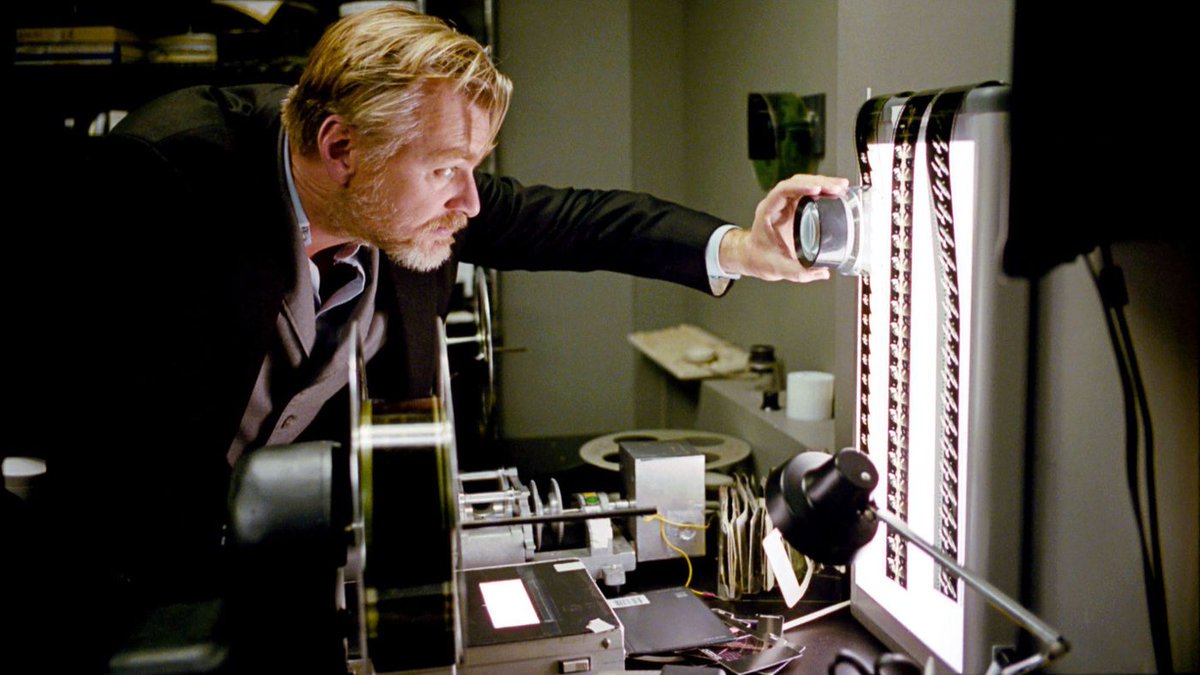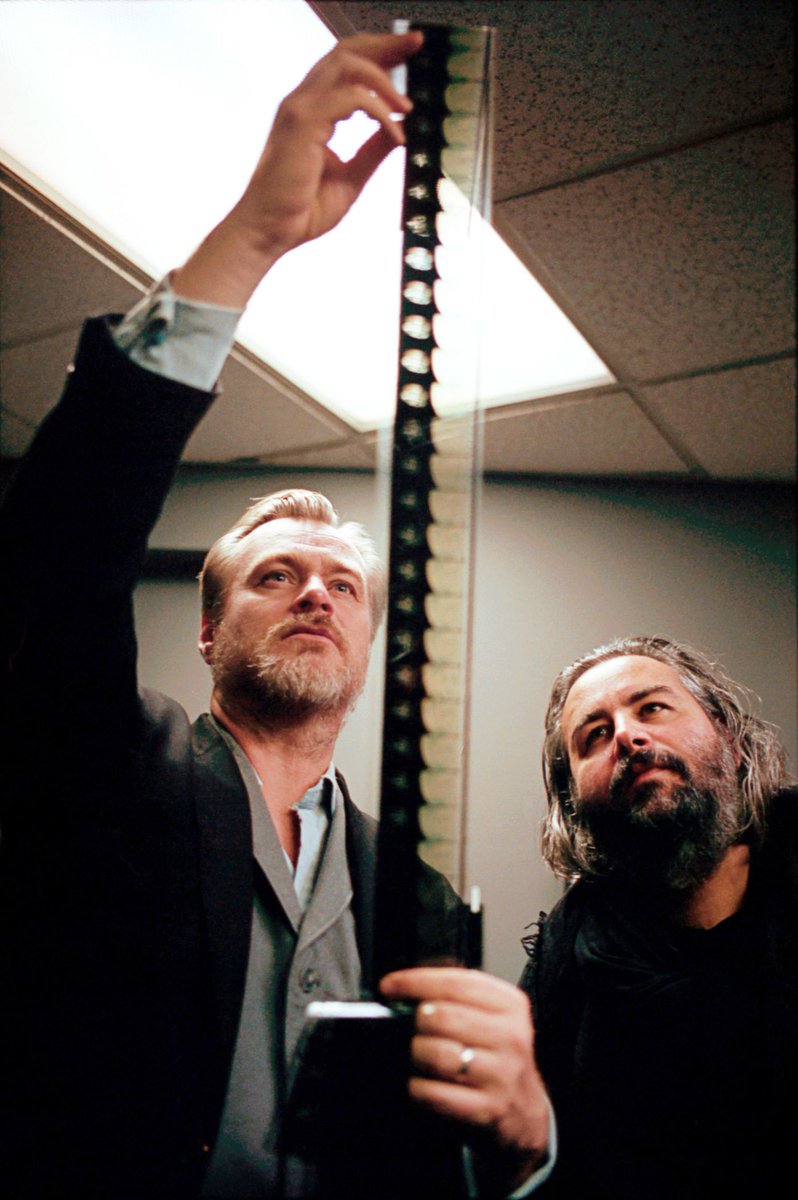
2001: A Space Odyssey (1968)

Can someone please copy and paste that whole thing so I don’t have to fucking sign up to read it?
Oh and these pictures are fucking amazingPioneerr wrote: ↑May 5th, 2018, 9:20 amDunno if this has been posted here already: Hoyte and Chris supervising the unrestored prints of Stanley Kubrick’s ‘2001: A Space Odyssey’ for the Warner Bros. Archives. By Roko Belic for Los Angeles Times.
http://www.latimes.com/entertainment/mo ... story.html
going the 20th for this, we'll see
-Vader
-Vader
When I was seven, my father took me to see Stanley Kubrick’s 2001: A Space Odyssey in Leicester Square. I’d seen Star Wars earlier that year and was obsessed with anything to do with spaceships. I didn’t know much about Kubrick’s film, other than this was the more “grown-up” space film.AsianVersionOfET wrote: ↑May 7th, 2018, 3:15 pmCan someone please copy and paste that whole thing so I don’t have to fucking sign up to read it?
I was transformed by the experience, from the “Dawn of Man” sequence at the beginning with the apes and that leopard with its eerie glowing eyes, to the beautiful spinning space station, to HAL the computer singing “Daisy, Daisy”, to the stunning “Stargate” sequence at the end. I can remember vividly the sheer sense of scale. The screen felt enormous, as if it were opening up to let the audience through and on a journey.
Ever since, that’s been my aspiration as a film maker, to take the audience somewhere they never knew they could go. 2001: A Space Odyssey is the film that first showed me movies can be anything. It’s not that it breaks all the rules. It’s a film that doesn’t acknowledge that there are any rules. It’s the punk rock of movies.
I must have watched the film a dozen times in the past few months as I supervised Warner Brothers’ remastering of the film. Last summer, I was working to master seven of my films onto the new 4K Ultra HD home-video format — a process in which I project reels of celluloid film, compare it to the digital projection and try to match them as closely as possible. Ned Price, vice president of restoration at the studio, said: “We’re doing the same thing for 2001 for its 50th anniversary — do you want to take a look at an original negative print?” And I said: “Oh, absolutely.” We put it up on the projector and watched a couple of reels without sound. It looked stunning.
Seeing it in its original photochemical form, it had incredible immediacy. Utterly fresh. It gave me an idea: Warner Brothers had acquired a large number of 70mm projectors last year in support of the release of my film Dunkirk. They were looking for new opportunities to use the projectors. What if we could make brand-new 70mm prints for a rerelease?
I’m calling the print we’ll be showing at Cannes next Sunday the “unrestored” version, meaning there are no digital tricks, remastered effects or revisionist edits. The new prints were struck from printing elements made from the original camera negative and were created entirely photochemically. This recreates the cinematic event audiences experienced 50 years ago in all its analogue glory. The film is absolutely as radical and experimental as it was in 1968, which is odd to realise, because movie conventions have changed massively in the past 50 years. But when you screen it today, the first time you see that rotating space station and hear Strauss’s Blue Danube waltz, you have a tremendously emotional response to that marriage of sound and image. It hasn’t faded.
The crew thought Kubrick was crazy when he asked one of them to go and buy up a shopload of classical music — Strauss, Ligeti — dropping the needle into grooves to find which tracks worked. Nobody had ever used classical music in a sci-fi film like that before. So many of the things that work in the film shouldn’t have worked. It’s an alien contact film where the actual contact is, to say the least, elliptical, and the most memorable character is a computer.
When Kubrick premiered the film in Washington and New York, there were hundreds of walkouts — from a premiere. It was a disaster. The critics ripped it to shreds. There were boos, hisses, co-writer Arthur C Clarke was in tears. One MGM exec muttered: “Well, that’s the end of Stanley Kubrick.” Right from day one, though, audiences were in line around the block. It was a phenomenon: the No 1 film at the box office for 1968. How many films can you say that about — a masterpiece by a film maker hitting his peak that is reviled by critics yet almost instantaneously taken up by devoted audiences, rather than having to wait for the proverbial “test of time”?
Part of its success came down to the countercultural element at the time, which took the film as a piece of psychedelia — MGM did release a campaign that year, selling it as “the ultimate trip” — but the truth is there were all kinds of people coming to that movie. For young people, particularly, it opened a window onto the possibilities of what movies could be. It just changed everything.
What’s given it such lasting power, I think, is the primal simplicity of all the story elements: Kubrick stripped everything down to its absolute essence. There’s less than 40 minutes of spoken dialogue in 142 minutes of running time. There was supposed to be a narration, penned by Clarke, that explained everything from the Dawn of Man sequence to HAL’s motivation — Kubrick got rid of all of it. The film is based instead on giving people a direct experience of wonder and awe, rather than using characters who react on the audience’s behalf and underline what we’re supposed to feel. It works directly on the audience and their emotions.
“He wanted it first-person,” said the effects supervisor Douglas Trumbull, who helped create that incredible striated rollercoaster of light at the end — the “Stargate” sequence — with coloured gels, transparent artwork and streak photography. I don’t know whether it’s something to do with the tactile, handmade quality of the imagery, the fact that everything is photographically derived, rather than rendered on a computer, but something makes a huge difference to people’s emotional involvement. And the sound mix is one of the most radical I’ve ever heard. I like to mix my own films loud, but there are sonic peaks in 2001 that are far beyond anything I would ever dare to do. It’s shocking, the contrast between that and the silence of the space walks, punctuated only by the breathing of the astronauts.
That’s Kubrick’s breathing you hear. He put on a space helmet and recorded 30 minutes of his own breath: a “small segment of his human soundtrack”, as Michael Benson puts it rather beautifully in his book Space Odyssey: Stanley Kubrick, Arthur C Clarke and the Making of a Masterpiece. Kubrick literally breathed life into his own creation.
The film was financed and distributed by MGM, but was filmed and edited almost entirely in England, where Kubrick lived. It’s his first “British” film in a lot of ways. Everyone forgets Leonard Rossiter is in it, as a Russian scientist. There’s this wonderful moment of gamesmanship between him and Dr Heywood Floyd about the Russians being denied permission to land. They were clearly just snooping around. It’s all there, the language, the diplomacy, the bureaucracy. The performances get more layered the more you look at them.
It’s a celebration of humanity in many ways. When Kubrick makes that famous match-cut between the bone tossed up by the apes to the orbiting spacecraft, you feel great pride — not just that humans will be able to build those things, but also in how humans worked to make this film. Look what we can do.
Kubrick’s film pretty much predicted everything from iPads to video phones to flatscreen TVs: when Samsung took Apple to court to prove they didn’t own the idea of the iPad, they tried to submit 2001 as evidence. It’s astonishing to think that so many of the things we are wrestling with, or think we will have to wrestle with in the future, to do with artificial intelligence are contained in that simple standoff between HAL and the astronauts. It’s one of the most nail-biting sequences Kubrick ever filmed just in terms of pure suspense. One minute, the mission is going perfectly, and within just two or three moves it’s a duel to the death.
A lot of 2001 came out of Kubrick’s collaboration with his cast and crew; it was Gary Lockwood who came up with the idea of the two astronauts plotting against HAL in the pod, and the film’s associate producer, Victor Lyndon, who came up with the idea of HAL being able to lip-read what they are saying.
Watching it again recently, I realised I’d been misinterpreting a key moment of Dullea’s, when Hal offers to sing Daisy Bell (Bicycle Built for Two) — an idea of Arthur C Clarke’s after he had heard an IBM 7094 mainframe computer do the same at Bell Laboratories — and Dave Bowman says “Sing it for me”. I always read it as him wanting to relieve the tension, but what I now see in it is aggression. He says “Sing it for me” because he wants to hear HAL dying.
Kubrick wrestled with this scene — it was one of the most important to him. “I want this to be a murder,” he told his wife, Christiane, which is why he lit the scene red. The pathos belongs to HAL, even though he’s just wiped out most of the crew. You don’t often think of Hitchcock and Kubrick in the same breath, but there’s a very Hitchcock shift of empathy in the moment. You have to look back to the silent-era director DW Griffith to find anything as radical — as whole cloth a reinvention of what movies can be. A lot of film makers talk about “pure cinema”, but very few films actually try to live up to it. The film has been hugely influential for Spielberg, Lucas, James Cameron and countless others.
Star Wars took the quality of the effects of 2001 and made them fast, furious and exciting: action-oriented. For the zero-gravity fight sequence in Inception, I used a rotating centrifuge similar to the 38ft, 30-ton set Kubrick used to show Frank Poole jogging around the Discovery, shadowboxing. And when I made my sci-fi film Interstellar, I went back to the same miniature photography Kubrick used on 2001 to get closer to a sense of wonderment, a sense of reality, because we’ve never seen anything produced by computers that holds the eye the way analogue techniques do. It’s a powerful thing. I think 2001 is Kubrick’s masterpiece because it’s the film in which his predisposition to meticulous technical craftsmanship was the emotional centre. It’s the heart of the experience.
So I’m taking 2001: A Space Odyssey to Cannes as a film buff, as a lifelong fan of this movie. I think it’ll be a magical screening on May 13; members of Kubrick’s family, including his daughter, Katharina Kubrick, and his brother-in-law Jan Harlan will be there. And Keir Dullea will join us too. It’s really, to me, about trying to do right by one of the greatest film makers who ever lived.
We projected the print before it was sent to Cannes. My kids were there, and I let them bring some friends: I was curious as to what teenagers would think. It blew their minds, in the same way it blew minds in 1968. They’d never seen anything like it. That highlights how the types of movies they have been given all their lives are just one small subset of how you can make films. This movie just throws all that away. It shows you films can be absolutely anything.
The only bit I remember being truly baffled by when I first saw it was the “star child” at the end coming back to Earth. I can remember talking to my friends about what it all meant when I saw the movie a second time, but I don’t remember being frustrated — it was baffling, but kind of wild, primal. In some ways I understood it better then than I do now; children are remarkably open to that kind of pure experiential, immersive cinema. It’s something people have started to prize in cinema again, as television and streaming become so standard. When you take away the things television can do and leave the things only films can do, what are you left with? What you’re left with is 2001.
What most excites Nolan about these new "2001" prints is that they are a completely photochemical process, "which is why we chose to call this the unrestored version."

"The 1999 interpositive had been made with Kubrick's original notes. None of what we did was interpretive, we didn't correct mistakes, we didn't say 'maybe he would have liked to do it this way.' We used our technical expertise to make sure we got the best prints possible."

Last edited by Disney+'s solo2001 on May 7th, 2018, 4:08 pm, edited 1 time in total.
what's unclear is what the "photochemical" process actually was that they did. Since they talk about striking prints from original sources, but that isn't a 4 month long arduous process. It's possible they tried restoring/correcting color and print quality photochemically, but that would seem to go 'against' what Nolan said about there being no interpretation by Nolan on what 2001 "should" look like.
I'm guessing the actual UHD release will feature a lot more digital trickery / restoration. We'll see though, will report back.
-Vader
I'm guessing the actual UHD release will feature a lot more digital trickery / restoration. We'll see though, will report back.
-Vader
if i'm not conveying all of this through gifs then i'm failingVader182 wrote: ↑May 7th, 2018, 4:08 pmwhat's unclear is what the "photochemical" process actually was that they did. Since they talk about striking prints from original sources, but that isn't a 4 month long arduous process. It's possible they tried restoring/correcting color and print quality photochemically, but that would seem to go 'against' what Nolan said about there being no interpretation by Nolan on what 2001 "should" look like.
It’s a shit movie anyway



